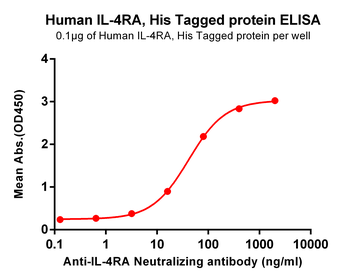You have no items in your shopping cart.
Cart summary

IL-31 Protein, Human, Recombinant
Catalog Number: orb1962166
| Catalog Number | orb1962166 |
|---|---|
| Category | Proteins |
| Description | Human Interleukin 31 (IL-31) is a cytokine containing a four-helix bundle structure. It shares several structural and functional characteristics with IL-6, Oncostatin M, LIF, and Cardiotrophin-1. Human IL-31 cDNA encodes a 164 amino acid precursor that contains a 23 amino acid signal peptide and a 141 amino acid mature protein. Human and mouse IL-31 share 24% sequence identity in the mature region. IL-31 is mainly associated with activated T cells and is preferentially expressed by type 2 helper T cells (Th2). IL-31 signals via a heterodimeric receptor complex composed of a gp130 related molecule termed IL-31RA (also GPL and GLMR) and an Oncostatin M receptor (OSM Rβ). The IL-31 receptor is constitutively expressed by keratinocytes and upregulated by IFNγ on monocytes. GPL/OSMR signaling is a strong activator of STAT3 and STAT5, and can also activate STAT1, Jak1, and Jak2 signaling pathways. IL-31 regulated immune responses have been implicated in skin physiology and inflammatory skin diseases. Studies have shown that IL31 induces severe pruritis (itching) and dermatitis in transgenic mice. |
| Tag | Tag Free |
| Purity | 98.00% |
| MW | 15 KDa (reducing condition) |
| UniProt ID | Q6EBC2 |
| Protein Sequence | Ser24-Thr164 |
| Expression System | E. coli |
| Biological Origin | Human |
| Biological Activity | Human Interleukin 31 (IL-31) is a cytokine containing a four-helix bundle structure. It shares several structural and functional characteristics with IL-6, Oncostatin M, LIF, and Cardiotrophin-1. Human IL-31 cDNA encodes a 164 amino acid precursor that contains a 23 amino acid signal peptide and a 141 amino acid mature protein. Human and mouse IL-31 share 24% sequence identity in the mature region. IL-31 is mainly associated with activated T cells and is preferentially expressed by type 2 helper T cells (Th2). IL-31 signals via a heterodimeric receptor complex composed of a gp130 related molecule termed IL-31RA (also GPL and GLMR) and an Oncostatin M receptor (OSM Rβ). The IL-31 receptor is constitutively expressed by keratinocytes and upregulated by IFNγ on monocytes. GPL/OSMR signaling is a strong activator of STAT3 and STAT5, and can also activate STAT1, Jak1, and Jak2 signaling pathways. IL-31 regulated immune responses have been implicated in skin physiology and inflammatory skin diseases. Studies have shown that IL31 induces severe pruritis (itching) and dermatitis in transgenic mice. |
| Expression Region | Ser24-Thr164 |
| Storage | -20°C |
| Note | For research use only |
| Application notes | Reconstitute the lyophilized protein in distilled water. The product concentration should not be less than 100 μg/ml. Before opening, centrifuge the tube to collect powder at the bottom. After adding the reconstitution buffer, avoid vortexing or pipetting for mixing. |
| Expiration Date | 6 months from date of receipt. |
Human IL31 protein (Active) [orb358986]
> 97% as determined by SDS-PAGE and HPLC.
15.8 kDa
E.Coli
500 μg, 100 μg, 10 μgHuman IL31 Protein, hFc Tag [orb1290941]
The purity of the protein is greater than 95% as determined by SDS-PAGE and Coomassie blue staining.
The protein has a predicted molecular mass of 42 kDa after removal of the signal peptide. The apparent molecular mass of IL31-hFc is approximately 35-55 kDa due to glycosylation.
Mammalian
50 μg, 10 μg, 100 μgHuman IL31 protein [orb595098]
Greater than 85% as determined by SDS-PAGE.
19.7 kDa
Baculovirus
1 mg, 20 μg, 100 μgHuman IL31 protein [orb604981]
Greater than 85% as determined by SDS-PAGE.
20.6 kDa
E.coli
20 μg, 100 μg, 1 mgHuman IL31 Protein, His Tag [orb2321287]
The purity of the protein is greater than 85% as determined by SDS-PAGE and Coomassie blue staining.
The protein has a predicted molecular mass of 17.2 kDa after removal of the signal peptide.
Mammalian
10 μg, 100 μg, 50 μg








